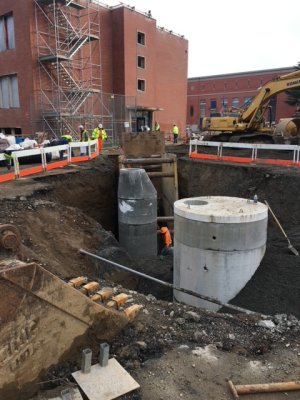
$200 Million Portland Public School Project
Overview
In 2017 a large portion of the Portland Public School$1.4 billion construction budget was a high-profile $200 million expansion and modernization of a large and historic high school. Extensive seismic and underground infrastructure upgrades were a large portion of the project scope.
The project Prime Contractor was a joint venture between a well-known Portland-based General Contractor, and a successful Portland-based minority-owned General Contractor. The civil construction subcontract was in the $5 million range, with multiple scopes of work as predecessors to the critical path work.
Problem
With an already tight 2-year project schedule, the project was complicated by upwards of a four-inch difference in elevations between many of the existing buildings and the new designs elevations. Many of the Contract Document elevations were affected. Protracted site surveys were needed to provide directions for the civil scope adjustments. Furthermore, the earliest school underground infrastructure dates back to the early 1920’s, so it was assumed to have many unknown elements.
The $5 million civil contract was awarded to a Portland-based minority–owned subcontractor. This subcontractor has had extensive success with previous civil projects, yet they were limited in their experience with this complex of a project.
The civil subcontractor was overwhelmed with the high-level and dynamic scheduling and reporting needed to manage this type of project. The early-work project scheduling changes, resulting from these elevation changes, greatly complicated the civil scope. The field crews were frustrated, and both of the management teams had great difficulty finding equitable pricing for these change orders. So change orders stagnated, and with unapproved change orders the civil subcontractor was unable to invoice for this work.
The field crews were behind schedule. This resulted in project delays and subsequent GC project-impact impact notifications. The erosion of trust and the increasing short-temperaments resulted in contract termination notification. This complex project scenario was quickly overwhelming the civil project team, while the pending termination of a highly visible minority-owned civil subcontractor was politically significant to all stakeholders.
Solution
Hartman Strong Hartman was contracted by the civil contractor at that insistence of their attorney. We knew that with a new client to us, with deepening exposure to multi-million dollars in lawsuits, and likely resulting in company failure, would be a heavy-lift for us.
In this situation, performing a job site review is critical to understanding the scale and scopes of the project. You meet the field team letting them know we are on board providing support. You meet the field GC management team; both to understand their issues and inform them we intend to leverage our involvement and move the project forward.
The posture of the GC team was respectful, yet doubtful of any positive change while leery of further delays. The GC had already contracted the alternate civil subcontractor bidder, and was on stand-by ready to take over immediately if the civil subcontractor was to default. This type of “takeover” could be disastrous for any subcontractor. The costs of using an alternate subcontractor are not subject to the existing subcontract values. Significant back charges would apply and our client would have little recourse.
Hartman Strong Hartman supported this project for over a year, mentoring our client while acting as the Project Executive for the civil subcontractor. We introduced the client to a national project-scheduling firm, who then supported the extensive scheduling process. We increased the levels of communication between the GC and the civil management. And we focused the civil field crews to better record daily field reports.
Hartman Strong Hartman implemented negotiated buy-outs of the civil scopes of work; whereby reducing the default-exposure of our client while increasing the civil resources needed for overall project schedule improvements.
This level of construction conflict is near impossible to be fully resolved in an equable and fair manner. Yet overall the project was completed on time, the subcontractor client is continuing to operate and be successful, and to my knowledge the GC joint-venture resolved any outstanding financial issues.
